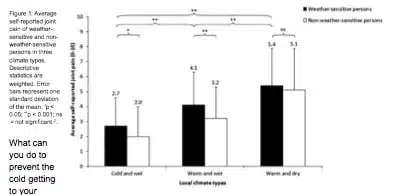Although you might not see it, your joints may certainly let you know winter is coming. There is little research that supports the effects of weather on joint pain. However, there is evidence that indicates there is a strong indication in people with Osteoarthritis,between joint pain and average humidity especially in cold weather conditions. The effect of humidity on pain was stronger in relatively cold weather conditions. The correlation is strong with a three day average, however there was no significant association between day-to-day weather changes 1.
Osteoarthritis (OA), is a degenerative joint disease characterized by damage and loss of articular cartilage and changes in bone. It is the most common cause of chronic pain in older persons and the leading cause of disability 2. A study was done with six different European countries with different climates, which identified characteristics of older persons with OA. Low temperature, high atmospheric pressure and high humidity shows a high correlation with pain in RA, low temperature and high humidity in OA, and low temperature and high atmospheric pressure in FM 3. Science behind all of this stipulates changes in temperature and humidity may influence the expansion and contraction of different tissues, such as muscles, fascia and connective tissue in the affected joints. As a result, this could elicit a pain response, which may discourage you from taking that mile walk in the morning. In addition, low temperatures in the environment may increase the viscosity of the synovial fluid, thereby making joints stiffer 2. This can further lead to more sensitivity to the pain of mechanical stresses your joints feel when you go to stand up. If you are reading this and are above the age of 65 years, female and have anxiety, you might find this information useful. You are a candidate whom might feel the effects of low temperature and humidity changes more than others. Research indicates, women and or who are more anxious, are more likely to report weather sensitivity (Figure 1). It is also suggested that weather affects mood, resulting in an alteration of pain perception2.
But why?… A possible explanation could be that poor mood might increase subjective complaints of pain or more anxious people with OA might tend to blame their symptoms on something they can comprehend but cannot control more than less anxious people with OA2.
What can you do to prevent the cold getting to your joints?… Early treatment such as exercise or even physical therapy for weather-sensitive individuals with OA, especially women can help. Doing different strengthening and balance exercises on top of cognitive and psychological interventions may reduce suffering and may help maintain a functional lifestyle 2.
Since there is some evidence out there supporting the relationship between joint pain in OA and weather, this may help individuals with OA, physicians, and therapists to help better understand and manage fluctuations in pain1. Next time you find yourself blaming the weather for your knee pain, you might want to smile before getting out of that blanket to change your mood.

Citations
Timmermans EJ, Schaap LA, Herbolsheimer F, et al. The Influence of Weather Conditions on Joint Pain in Older People with Osteoarthritis: Results from theEuropean Project on OSteoArthritis. J Rheumatol. 2015;42(10):1885-92.
Timmermans EJ, Van der pas S, Schaap LA, et al. Self-perceived weather sensitivity and joint pain in older people with osteoarthritis in six European countries: results from the European Project on OSteoArthritis (EPOSA). BMC Musculoskelet Disord. 2014;15:66.
Strusberg I, Mendelberg RC, Serra HA, Strusberg AM. Influence of weather



